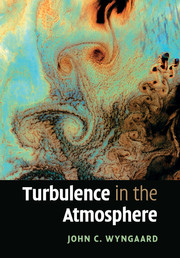Book contents
- Frontmatter
- Contents
- Preface
- Part I A grammar of turbulence
- Part II Turbulence in the atmospheric boundary layer
- 8 The equations of atmospheric turbulence
- 9 The atmospheric boundary layer
- 10 The atmospheric surface layer
- 11 The convective boundary layer
- 12 The stable boundary layer
- Part III Statistical representation of turbulence
- Index
12 - The stable boundary layer
from Part II - Turbulence in the atmospheric boundary layer
Published online by Cambridge University Press: 11 April 2011
- Frontmatter
- Contents
- Preface
- Part I A grammar of turbulence
- Part II Turbulence in the atmospheric boundary layer
- 8 The equations of atmospheric turbulence
- 9 The atmospheric boundary layer
- 10 The atmospheric surface layer
- 11 The convective boundary layer
- 12 The stable boundary layer
- Part III Statistical representation of turbulence
- Index
Summary
Introduction
The stable boundary layer (SBL) is as different from the convective boundary layer (CBL) as night is from day. The SBL is typically much thinner and much less diffusive; chimney plumes in the stable air just after sunrise can travel intact for long distances, quite unlike those in midday. The decrease in surface wind speed around sunset on a clear day, which is prominent in wind climatologies (Arya, 2001), is also evident to casual observers. Figure 12.1 shows the root cause: in a given mean horizontal pressure gradient the surface mean wind speed is lower in stable stratification than in neutral or unstable stratification. Thus the lower nocturnal wind speeds tend to persist until the initiation of a CBL at sunrise.
We gave examples of SBLs in Chapter 9. The two sketched in Figure 9.7 are made stably stratified by flow over a cooler surface and by entrainment of warmer air aloft. Perhaps the most common example is the nocturnal SBL over land in fair weather. Another is the “long-lived” SBL at the South Pole; it is caused by a combination of a temperature inversion over a cooled, sloped surface and the typically downslope orientation of the mean pressure gradient (Neff et al., 2008).
As we'll see, turbulence in the SBL tends to be in a delicate dynamical balance, and so SBL structure tends to be more difficult to study and to parameterize than that in the CBL.
- Type
- Chapter
- Information
- Turbulence in the Atmosphere , pp. 267 - 294Publisher: Cambridge University PressPrint publication year: 2010



